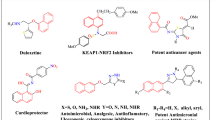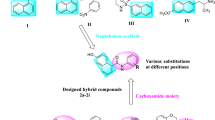Abstract
α-Glucosidase is responsible for glucose release of oligosaccharides and disaccharides in the intestine and increase postprandial hyperglycemia. Inhibition of this enzyme is a beneficial therapeutic method for glycemic control in diabetes. This study deals with the design and synthesis of 4,5-diphenylimidazole-N-phenylacetamide derivatives 7a–l and the screen of these compounds for their potential for α-glucosidase inhibition. All the synthesized compounds exhibited superior α-glucosidase inhibition (IC50 = 90.0–598.5 µM) as compared to standard inhibitor acarbose (IC50 = 750.0 µM). In contrast, these compounds were inactive against α-amylase. Among the synthesized compounds, compound 7h was the most potent inhibitor of this library and was a competitive inhibitor into α-glucosidase with Ki value = 86.3 μM. Docking study of the most potent compounds was performed to evaluate the binding interactions of these compounds with the active site of enzyme and to determine of binding energies of ligand–enzyme complexes. The results of this in silico study are in complete agreement with the results obtained from in vitro α-glucosidase inhibition assay. Docking study of the most potent compound demonstrated that it interacted with important residues in the active site of α-glucosidase. In vitro cytotoxic activity of the most potent compounds and in silico druglikeness/ADME/toxicity study of these compounds were evaluated.






Similar content being viewed by others
References
Zimmet P, Alberti KG, Kaufman F, Tajima N, Silink M, Arslanian S, et al. The metabolic syndrome in children and adolescents–an IDF consensus report. Pediatr Diabetes. 2007;8:299–306.
Ozougwu JC, Obimba KC, Belonwu CD, Unakalamba CB. The pathogenesis and pathophysiology of type 1 and type 2 diabetes mellitus. J Physiol Pharm. 2013;4:46–57.
Fronzo DE. The triumvirate: SS-cell, muscle, liver-a collusion responsible for NIDDM. Diabetes. 1988;37:667–87.
Chamberlain JJ, Kalyani RR, Leal S, Rhinehart AS, Shubrook JH, Skolnik N, et al. Treatment of type 1 diabetes: synopsis of the 2017 American Diabetes Association Standards of Medical Care in Diabetes. Ann Intern Med. 2017;167:493–8.
Cervera A, Wajcberg E, Sriwijitkamol A, Fernandez M, Zuo P, Triplitt C, et al. Mechanism of action of exenatide to reduce postprandial hyperglycemia in type 2 diabetes. Am J Physiol Endocrinol Metab. 2008;294:E846–52.
Derosa G, Maffioli P. α-Glucosidase inhibitors and their use in clinical practice. Arch Med Sci AMS. 2012;8:899.
Leroux-Stewart J, Rabasa-Lhoret R, Chiasson JL. α-Glucosidase inhibitors. Ther Diabetes Mellit Relat Disord. 2014;2:416.
Dong Y, Zhang B, Sun W, Xing Y. Intervention of prediabetes by flavonoids from Oroxylum indicum. In: Watson RR, Preedy VR, editors. Bioactive food as dietary interventions for diabetes. London: Academic Press, p. 559–575 2019.
Asif M. A mini review: biological significances of nitrogen hetero atom containing heterocyclic compounds. Int J Bioorg Chem. 2017;2:146–52.
Hossain M, Nanda AK. A review on heterocyclic: synthesis and their application in medicinal chemistry of imidazole moiety. Science. 2018;6:83–94.
Shalini K, Sharma PK, Kumar N. Imidazole and its biological activities: a review. Der Chem Sin. 2010;1:36–47.
Bhatnagar A, Sharma PK, Kumar N. A review on “Imidazoles”: their chemistry and pharmacological potentials. Int J PharmTech Res. 2011;3:268–82.
Gupta V, Kant V. A review on biological activity of imidazole and thiazole moieties and their derivatives. Sci Int. 2013;1:253–60.
Rani N, Sharma A, Kumar Gupta G, Singh R. Imidazoles as potential antifungal agents: a review. Mini Rev Med Chem. 2013;13:1626–55.
Yar M, Bajda M, Shahzad S, Ullah N, Gilani MA, Ashraf M, et al. Organocatalyzed solvent free an efficient novel synthesis of 2, 4, 5-trisubstituted imidazoles for α-glucosidase inhibition to treat diabetes. Bioorg Chem. 2015;58:65–71.
Asgari MS, Mohammadi-Khanaposhtani M, Sharafi Z, Faramarzi MA, Rastegar H, Esfahani EN, et al. Design and synthesis of 4,5‑diphenyl‑imidazol‑1,2,3‑triazole hybrids as new anti‑diabetic agents: in vitro α‑glucosidase inhibition, kinetic and docking studies. Mol Divers. 2020. https://doi.org/10.1007/s11030-020-10072-8
Saeedi M, Mohammadi-Khanaposhtani M, Asgari MS, Eghbalnejad N, Imanparast S, Faramarzi MA, et al. Design, synthesis, in vitro, and in silico studies of novel diarylimidazole-1,2,3-triazole hybrids as potent α-glucosidase inhibitors. Bioorg Med Chem. 2019;27:115148.
Mohammadi-Khanaposhtani M, Rezaei S, Khalifeh R, Imanparast S, Faramarzi MA, Bahadorikhalili S, et al. Design, synthesis, docking study, α-glucosidase inhibition, and cytotoxic activities of acridine linked to thioacetamides as novel agents in treatment of type 2 diabetes. Bioorg Chem. 2018;80:288–95.
Ye GJ, Lan T, Huang ZX, Cheng XN, Cai CY, Ding SM, et al. Design and synthesis of novel xanthone-triazole derivatives as potential antidiabetic agents: α-Glucosidase inhibition and glucose uptake promotion. Eur J Med Chem. 2019;177:362–73.
Asemanipoor N, Mohammadi-Khanaposhtani M, Moradi S, Vahidi M, Asadi M, Faramarzi MA, et al. Synthesis and biological evaluation of new benzimidazole-1, 2, 3-triazole hybrids as potential α-glucosidase inhibitors. Bioorg Chem. 2020;95:103482.
Adib M, Peytam F, Rahmanian-Jazi M, Mahernia S, Bijanzadeh HR, Jahani M, et al. New 6-amino-pyrido[2, 3-d] pyrimidine-2, 4-diones as novel agents to treat type 2 diabetes: a simple and efficient synthesis, α-glucosidase inhibition, molecular modeling and kinetic study. Eur J Med Chem. 2018;155:353–63.
Sepehri N, Asemanipoor N, Mousavianfard SA, Hoseini S, Faramarzi MA, Adib M, et al. New acridine-9-carboxamide linked to 1, 2, 3-triazole-N-phenylacetamide derivatives as potent α-glucosidase inhibitors: design, synthesis, in vitro, and in silico biological evaluations. Med Chem Res. 2020;29:1836–45.
Asgari MS, Mohammadi-Khanaposhtani M, Kiani M, Ranjbar PR, Zabihi E, Pourbagher R, et al. Biscoumarin-1, 2, 3-triazole hybrids as novel anti-diabetic agents: design, synthesis, in vitro α-glucosidase inhibition, kinetic, and docking studies. Bioorg Chem. 2019;92:103206.
Sherafati M, Mohammadi-Khanaposhtani M, Moradi S, Asgari MS, Najafabadipour N, Faramarzi MA, et al. Design, synthesis and biological evaluation of novel phthalimide-Schiff base-coumarin hybrids as potent α-glucosidase inhibitors. Chem Pap. 2020;74:4379–88.
Imran S, Taha M, Ismail NH, Kashif SM, Rahim F, Jamil W, et al. Synthesis of novel flavone hydrazones: in-vitro evaluation of α-glucosidase inhibition, QSAR analysis and docking studies. Eur J Med Chem. 2015;105:156–70.
Imran S, Taha M, Ismail NH, Kashif SM, Rahim F, Jamil W, et al. Synthesis, in vitro and docking studies of new flavone ethers as α‐glucosidase inhibitors. Chem Biol Drug Des. 2016;87:361–73.
Kiefer F, Arnold K, Künzli M, Bordoli L, Schwede T. The SWISS-MODEL Repository and associated resources. Nucleic Acids Res. 2009;37:D387–92.
Abolhasani MH, Safavi M, Goodarzi MT, Kassaee SM, Azin M. Identification and anti-cancer activity in 2D and 3D cell culture evaluation of an Iranian isolated marine microalgae Picochlorum sp. RCC486. DARU J Pharm Sci. 2018;26:105–16.
Bioinformatics and Molecular Design Research Center. Pre-ADMET program. Bioinformatics and Molecular Design Research Center, Seoul, South Korea. 2014. http://preadmet.bmdrc.org
Funding
This work was financially supported by Babol University of Medical Sciences (the grant number: 724132438). The ethics code for this study is IR.MUBABOL.HRI.REC.1398.181.
Author information
Authors and Affiliations
Corresponding authors
Ethics declarations
Conflict of interest
The authors declare no competing interests.
Additional information
Publisher’s note Springer Nature remains neutral with regard to jurisdictional claims in published maps and institutional affiliations.
Supplementary information
Rights and permissions
About this article
Cite this article
Mohammadi-Khanaposhtani, M., Nikraftar, A., Asgari, M.S. et al. Synthesis, in vitro and in silico enzymatic inhibition assays, and toxicity evaluations of new 4,5-diphenylimidazole-N-phenylacetamide derivatives as potent α-glucosidase inhibitors. Med Chem Res 30, 1273–1283 (2021). https://doi.org/10.1007/s00044-021-02734-5
Received:
Accepted:
Published:
Issue Date:
DOI: https://doi.org/10.1007/s00044-021-02734-5




